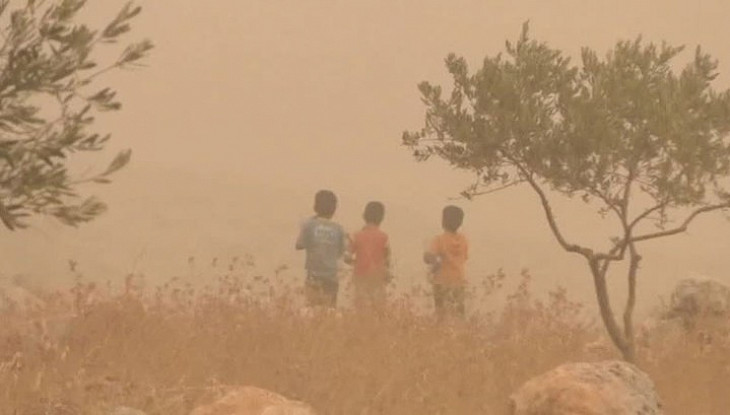The frequency and intensity of dust and sand storms in Tajikistan have increased significantly, but economic assessment of their impact remains limited and in some cases completely absent, Asiaplus.tj reports.
According to the UN Convention to Combat Desertification (UNCCD), around 2 billion tons of sand and dust are released into the atmosphere every year, which is equivalent to the weight of 350 Great Pyramids of Giza. Despite this, these extreme weather events remain underappreciated.
In recent decades, the frequency and intensity of dust storms have increased in some arid regions due to changes in land use and vegetation cover, as well as shifting climate factors. Experts warn that if mitigation measures are not taken, the adverse effects of dust and sandstorms will become even more severe.
It is already becoming evident that these events can undermine the economic development of countries and jeopardize the achievement of some Sustainable Development Goals. Economic losses from a single large storm can amount to hundreds of millions of dollars.
International concern about dust and sandstorms and the recognition of the need for joint efforts to prevent, predict, and mitigate their effects led the UN General Assembly to declare the Decade (2025-2034) for Combating Sand and Dust Storms.
Multifaceted impact of dust and sand storms
The cumulative damage from dust and sandstorms can be significant. In the regions where these storms originate, there is a decline in agricultural yields, livestock losses, and depletion of the fertile soil layer. In areas affected by the storms, air and water quality deteriorate, and transportation is disrupted. These weather events can also negatively impact infrastructure and equipment, halting or restricting the provision of services and the supply of goods.
Dust and sand storms affect hundreds of millions of people worldwide, from sub-Saharan Africa to northern China and Australia. Yet, the number of economic impact assessments for such storms is very limited. According to the UNCCD Compendium on Sand and Dust Storms, the first attempts to assess economic damage were made in the mid-1980s, when experts tried to calculate the external costs of dust storms for businesses and households in New Mexico, USA.
Today, various approaches exist for measuring the economic impact of these weather phenomena. The effects of dust and sandstorms are multifaceted and often transnational.
Economic costs of dust and sand storms: examples of assessments
According to available data, the Middle East and North Africa region alone loses about US$13 billion annually due to increasingly frequent sand and dust storms. In northern China, between 2010 and 2013, these storms caused nearly US$1 billion in economic losses.
Experts dealing with the economic consequences of dust and sand storms agree that the main challenge is collecting and analyzing relevant data, as the damage depends on many factors. They also note that any economic impact calculation will be an estimate and will always carry some degree of error.
Is the damage from dust and sand storms in Central Asia beyond calculation?
More than 80% of the approximately 400 million hectares of Central Asia’s land are covered by deserts and steppes. Combined with climate change and prolonged droughts, this creates a natural source of sand and dust storms.
Unstable irrigation farming practices, overgrazing, mining, deforestation, and other activities contribute to the creation of anthropogenic sources of storms. According to the Regional Mid-Term Strategy for Managing Sand and Dust Storms in Central Asia (2021-2030), the total area exposed to medium and high risk of dust and sand storms in the region is about 85 million hectares. Nearly 6.5 million people, or 9% of Central Asia’s population, live in high-risk areas.
One of the main consequences of dust and sandstorms in the region is land degradation and reduced agricultural yields. This affects food security and farmer incomes, which are the foundation of the economies of many Central Asian countries. Dust also affects glaciers, accelerating ice melt, especially in the Tien Shan and Pamir mountains.
Growing concern over dust storms in Tajikistan
According to the National Academy of Sciences of Tajikistan, the number of dust storms in the country has increased tenfold in the past 30 years. In the National Climate Change Adaptation Strategy for the period up to 2030, dust and sandstorms ranked third among 14 prioritized climate risks.
Local experts agree that these natural disasters are increasingly affecting the health of the population and the economy, but the scale and extent of this impact have largely not been defined.
The National Action Plan for Preventing and Mitigating the Effects of Dust and Sand Storms in Tajikistan for 2022-2030, notes that "preliminary damage estimates from dust and sand storms in the Strategy are around US$450,000 annually."
However, Mirzo Saidov, a leading national expert involved in the development of the National Action Plan, commented that the new version of the document contains an error, and the actual figure is US$45,000.
In Tajikistan, dust storms pose risks to agriculture, from soil degradation to crop damage. At the same time, this sector remains a source of employment and livelihoods for a significant part of the population and is the most vulnerable to climate change.
Another concerning impact of the storms is the degradation of glaciers. Even though glacial melt accounts for only 10-20% of the annual river flow, its importance cannot be overstated. 80% of Tajikistan’s glacial water flows into neighboring countries through the Zeravshan, Amu Darya, and Syr Darya rivers.
No such studies have been conducted in Tajikistan
It should be acknowledged that Tajikistan lacks substantial experience in managing and preventing sand and dust storms.
Despite the relevance of research related to these phenomena in Tajikistan, very limited work is being conducted in this area. There is a shortage of qualified specialists and insufficient scientific and technical capacity.
CentralasianLIGHT.org
October 15, 2024

